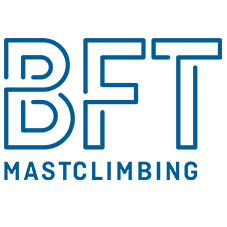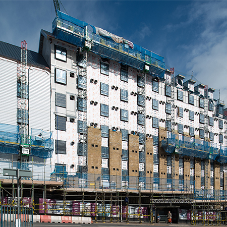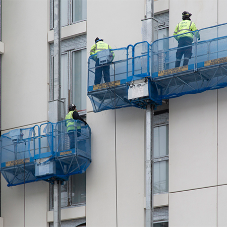It’s likely that over the next 12-18 months more and more cladding projects are going to commence. With that being the case, there’s naturally going to be high demand for cost-efficient and more productive means of completing the work.
On top of this, it’s important to find a vertical access solution that suits residents within the buildings, too. After all, it’s their home that is being disrupted, so why should they have to put up with months of being fully enclosed, away from natural daylight?
The removal of unsafe cladding is just the tip of the iceberg and there are so many other projects that will require the use of efficient vertical access.
That’s why BFT Mastclimbing sat down with Cliff Woodhouse, Business Development Director at d+b facades to discuss his industry’s approach to mast climbers and why they should be the only consideration for vertical access on cladding projects, ideal for project managers and residents alike.
Mast Climbers Make Life Much Easier For Installation
Cliff would be the first to admit he’s been working in the industry for some time. His nearly 20 years at d+b facades are predated by continuous work in the sector. During this time with d+b Facades in particular, Cliff admits that mast climbers have always seemed to go hand-in-hand with the work he’s been completing.
“I can’t remember a job where we haven’t used them.” he jokes.
“The work we do ranges across various sectors, from tower blocks, to universities, hospitals and colleges. The common denominator is that they’re high rise and they’re occupied. That’s what our speciality is.”
But what makes a mast climber so suited to this particular type of work?
For one, they make the process of removing and fitting large cladding panels much easier.
“The beauty of the mast climber is that it can take us up and down smoothly and efficiently. It’s more than adequate to take the loads of our rain screens, rails, insulation, everything we need.”
But you’re probably wondering why d+b don’t have the same thinking when it comes to using scaffolding.
Why Not Scaffolding?
“Scaffolding often presents us with various problems,” Cliff suggests.
“Firstly, it’s just not flexible enough for what we need.
It’s high risk when it is erected and fixed to the building unless very carefully designed. There can be clashes with the products when we’re installing them, the innertubes might be too close to where the cladding goes and we need to avoid other things as well.”
This is a common issue when you compare the advantages and disadvantages of scaffolding and mast climbers. While the two provide vertical access, they do so in entirely different ways which can impact the effectiveness of the work completed.
“There’re other problems when we use it [scaffolding] too. Because you’ve got fixed boarded levels all the way up the building, sometimes, they are in the wrong place. It’s not terribly flexible and you need to create hop-ups in order to complete your job."
All of these potential headaches are before you even consider the cost difference between the two. The scaffolding price needs to factor in unexpected costs that you just don’t get with a mast climber; in fact, you can expect to save around 60% on scaffolding if you use a mast climber on a building over 20 storeys.
“There’s the issue of handling materials and tools with scaffolding. You can load up the mast climber and get on with it, but scaffolding requires goods hoists where effectively you make the site more inaccessible i.e wherever there is a goods hoist you have effectively divided the site into two halves. On top of that, these hoists aren’t cheap, and costs soon add up.”
That’s not to say that scaffolding is a non-starter. Projects vary and it really depends on the scale of your building.
The ideal solution is a combination of both mast climbers for vertical access and scaffolding for public protection and that is commonly the solution that d+b Facades opt for.
Post Grenfell Cladding Removal
BFT Mastclimbing can’t discuss cladding without mentioning Grenfell.
With £5bn set aside to fund repairs, Cliff predicts there’s going to be a “bit of a log jam” for the industry based on the amount of work they’ve already costed up.
“Recently, we have found ourselves pricing a lot of fire safety projects and probably 40% of our turnover is fire safety related. This has all been done to meet the deadlines for the Building Safety Fund, so when they’re ready to go, there will be a lot of work and it will need to be completed efficiently. That’s why we’ll use mast climbers.”
As the first company to remove combustible cladding from a high-rise block following the Grenfell disaster, d+b Facades are the industry leaders within the sector, which is partly down to the speed mast climbers allow them to work at.
“On that high rise project [the first following Grenfell] it took 10 days to remove all the unsafe cladding. There’s no way that would happen with scaffolding.”
Saving time is essential, whatever aspect of the project you’re working on. Whether it’s to meet deadlines or to quickly remove unsafe material, mast climbers can be hugely advantageous.
Because of this particular fire safety requirement, there’s huge potential for the mast climbing industry to grow.
As Cliff sums up “I can see significant growth in the mast climbing sector because of the necessary work for fire safety. With a tendency to build high, limited space and access surrounding these plots, it’s the only logical answer.”
Ventilation, Light & Better Mental Health: Why Residents Need Mast Climbers
Construction work by its very nature is somewhat intrusive. It’s loud, it’s large and it can get in the way. That’s especially the case when you’re working on the external part of the building, which is what d+b Facades do each and every day.
Protecting residents from unsafe material is one thing, but it’s important to protect them during reparative process as well. This goes beyond protecting them and their properties, but protects their mental health, too.
Because scaffolding on high rise buildings needs to be netted out, residents experience a significant loss of day light, particularly in the winter months.
“On top of that, scaffolding also limits the ventilation” Cliff adds. “In fact, there are two reasons why scaffolding isn’t the best option. The first is the lack of privacy, workers will be walking past your living room every few minutes. On top of that is the security risk scaffolding can bring. Anyone can climb it and potentially enter your property.”
Mast climbers eradicate this problem. The single platform means that daylight isn’t restricted and there is no imposing of residents. And while technically masts could be climbed, the single platform is disabled during the night so there is no easy way for criminals to access property.
“What we also do is put a privacy glass on the outside of the window. What this means is that residents can look out, but the workers can’t look in. There are also things like adding window restrictors so there can be nothing that can damage the mast climber as it’s ascending or descending.”
Mast Climbers Savings: Money & Time
“To put it simply, our turnover is in the region of £25million. A large part of that is down to the efficiency of mast climbers and therefore our projects.” Cliff summarises.
Helping save time on site is one thing, but cost is as important too. BFT Mastclimbing has explored both and scaffolding can sometimes throw up some surprises you can’t always anticipate at the tendering stage.
One of the most common phrases BFT Mastclimbing hears is ‘we’ve done it this way for so long, why change?’. But BFT Mastclimbing can see there is good reason to change. Not just the benefits of time and spend savings, but from a residential point of view, too.
Residents are often overlooked but are arguably the most important people in any construction project.
Cliff is convinced mast climbers are an important factor in meeting all of these factors, and it’s crucial you find a partner to help.
“Access plays an important role in what we do. We’ve worked with BFT for 15 years or so, a very good relationship. We can go for a one-stop solution, and they always deliver.”
Why All Cladding Projects Need To Consider Mast Climbers
| T | 0808 178 9772 |
|---|---|
| E | rob.munns@bftmastclimbing.com |
| W | Visit BFT Mastclimbing Ltd's website |
| The Rear Yard, Lancer Court, Grovebury Road, Leighton Buzzard, Bedfordshire, LU7 4SE |





